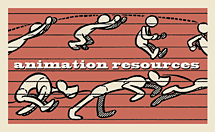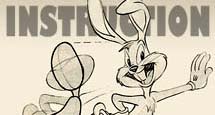This posting is a stub. You can contribute to this entry by providing information through the comments link at the bottom of this post. Please organize your information following the main category headers below….
Birth/Death
Birth: Feb 7, 1904
Death: March 1976
Occupation/Title
Animator, Director, Writer
Bio Summary
He worked in animation in New York, Hollywood and Florida
Early Life/Family
He was born in Bridgeport Connecticut USA.
Education/Training
Career Outline
He began working in animation in New York City, at the Aesop’s Fables Studio, around 1926. He did a Brief stint at Disney in Hollywood then went to work at MGM in 1938. He then went to the Fleisher brother’s studio at the time located in Miami Florida. In 1946 he went to Terry Toons at Twentieth Century Fox in New York City. He left Terry Toons in 1959. He worked on various projects such as producing animation and most notably before his death he worked on the feature film Fritz The Cat.
Comments On Style
A style all his own. Some characters are drawn with incorrect mouth movements. Or some characters have two mouths.
Influences
Personality
Anecdotes
Miscellaneous
Filmography
Animator:?
The Fatal Note (1933) (animator)
Cupid Gets his Man (1936) (animator) (uncredited)?You’re a Sap, Mr. Jap (1942) (animator) (as Jim Tyer)
Spinach Fer Britain (1943) (animator) (as Jim Tyer)
Seein’ Red, White ‘n’ Blue (1943) (animator) (as Jim Tyer)
Her Honor the Mare (1943) (animator) (as Jim Tyer)
Puppet Love (1944) (animator) (as Jim Tyer)
Moving Aweigh (1944) (animator) (as Jim Tyer)
She-Sick Sailors (1944) (animator) (as Jim Tyer)
Shape Ahoy (1945) (animator)
Cheese Burglar (1946) (animator) (as Jim Tyer)
Service with a Guile (1946) (animator)
Peep in the Deep (1946) (animator) (as Jim Tyer)
Rocket to Mars (1946) (animator) (as Jim Tyer)
The Island Fling (1947) (animator) (uncredited)
The Royal Four-Flusher (1947) (animator) (uncredited)
Dingbat Land (1949) (animator) (uncredited)?The Lyin’ Lion (1949) (animator) (uncredited)?Dream Walking (1950) (animator) (uncredited) ?Steeple Jacks (1951) (animator) (uncredited)?The Helpful Geni (1951) (animator) (uncredited)?The Cat’s Tale (1951) (animator) (uncredited)?Papa’s Little Helpers (1951) (animator) (uncredited)?Papa’s Day of Rest (1951) (animator) (uncredited)?Off to the Opera (1952) (animator) (uncredited)?House Busters (1952) (animator) (uncredited)?Pill Peddlers (1952) (animator) (uncredited)
Featherweight Champ (1953) (animator) (uncredited)?Playful Puss (1953) (animator) (uncredited)
Plumber’s Helpers (1953) (animator) (uncredited)
Ten Pin Terrors (1953) (animator) (uncredited)
Hot Rods (1953) (animator) (uncredited)
When Mousehood Was in Flower (1953) (animator) (uncredited)
Bargain Daze (1953) (animator)
Log Rollers (1953) (animator) (uncredited)
Blind Date (1953) (animator)
Prescription for Percy (1954) (animator) (uncredited)
The Cat’s Revenge (1954) (animator)?Barnyard Actor (1955) (animator) (uncredited)
No Sleep for Percy (1955) (animator) (uncredited)
Miami Maniacs (1955) (animator) (uncredited)
Lucky Dog (1956) (animator)?Pirate’s Gold (1956) (animator) (uncredited)?”The Heckle and Jeckle Show” (1956) TV series (animator: theatrical cartoon segments)?”Tom Terrific” (1957) TV series (animator)?Topsy TV (1957) (animator) (as Jim Tyer)?Flebus (1957) (animator)?It’s a Living (1957) (animator) (as Jim Tyer)?Sidney’s Family Tree (1958) (animator)?Gaston’s Baby (1958) (animator)?Old Mother Clobber (1958) (animator) (as Jim Tyer)?Gaston’s Easel Life (1958) (animator)?Clobber’s Ballet Ache (1959) (animator)?The Flamboyant Arms (1959) (animator) (as Jim Tyer)?Foofle’s Train Ride (1959) (animator) (as Jim Tyer)?”Felix the Cat” (1960) TV series (animator) ?Aesop’s Fable: The Tiger King (1960) (animator) (uncredited)?”Out of the Inkwell” (1961) TV series (animator) (1961) ?… aka Max Fleischer Presents Out of the Inkwell (USA: complete title)?”Snuffy Smith and Barney Google” (animator) (2 episodes, 1963)? – Barney’s Winter Carnival (1963) TV episode (animator) ? – Snuffy’s Fair Lady (1963) TV episode (animator) (uncredited)
Hobo Hootenanny (1965) (TV) (animator)
“Milton the Monster” (1965) TV series (animator) (as Jim Tyer) ?… aka The Milton the Monster Show (USA)
The Moon Goons (1965) (TV) (animator)?Suit Yourself (1966) (TV) (animator)?Nuggets to You (1966) (TV) (animator)?Manhole Manny (1967) (TV) (animator)?The Kitchy-Koo Kaper (1967) (TV) (animator)?Goo-Goo a Go-Go (1967) (TV) (animator)?Greasy Gus (1967) (TV) (animator)?Roz the Schnozz (1967) (TV) (animator)?Bride and Doom (1967) (TV) (animator)?Slow Down! Speed Up! (1967) (TV) (animator)?Watch My Smoke (1967) (TV) (animator)?The Bomber Bird (1967) (TV) (animator)?Jerkules (1967) (TV) (animator)
Fritz the Cat (1972) (animator)
Director:
Marching Along (1933)
Pals (1933) (as Jim Tyer) ?… aka Christmas Up North (USA: TV title)
Grandfather’s Clock (1934) (uncredited)
Little Bird Told Me (1934) (uncredited)
?Writer:
You’re a Sap, Mr. Jap (1942) (story) (as Jim Tyer)?Think or Sink (1967) (writer) ?
Honors
Related Links
http://johnkstuff.blogspot.com/2009/05/that-wacky-jim-tyer.html
http://johnkstuff.blogspot.com/2008/10/jim-tyer-terrytoons-comics.html
Bibliographic References
BIO-AAA-105
Contributors To This Listing
Frank Sisto III
To make additions or corrections to this listing, please click on COMMENTS below…??




























